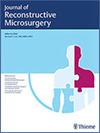Validation of novel microsurgical vessel anastomosis techniques: A systematic review.
IF 2.2
3区 医学
Q2 SURGERY
引用次数: 0
Abstract
INTRODUCTION Thorough validation of novel microsurgical techniques is deemed essential before their integration into clinical practice. To achieve proper validation, the design of randomized controlled trials (RCTs) should be undertaken, accompanied by the execution of comprehensive statistical analyses, including confounder adjustment and power analysis. This systematic review aims to provide an encompassing overview of the validation methodologies employed in microsurgical studies, with a specific focus on innovative vessel anastomosis techniques. METHODS A literature search was conducted in PubMed for articles describing the validation of novel microsurgical vessel anastomosis techniques in animal or human subjects. RESULTS The literature search yielded 6,658 articles. 6,564 articles were excluded based on title and abstract. Ninety-four articles were assessed for full-text eligibility. Forty-eight articles were included in this systematic review. Out of 30 comparative studies, nine studies validated novel modified interrupted suture techniques, six studies modified continuous techniques, six studies modified sleeve anastomosis techniques, one study a modified vesselotomy technique, seven studies sutureless techniques, and one study a modified lymphaticovenular anastomosis technique. Twenty-eight studies contained animals (n=1,998). Fifteen animal studies were RCTs. Two studies contained human/cadaveric subjects (n=29). Statistical power-analysis and confounder adjustment were performed in one animal study. Out of eighteen non-comparative studies, five studies validated novel modified interrupted suture techniques, one study a modified continuous technique, two studies modified sleeve anastomosis techniques, four studies modified vesselotomy techniques, four studies sutureless techniques, and two studies modified lymphaticovenular anastomosis techniques. Ten studies contained animal subjects (n=320), with two RCTs. Eight studies contained human subjects (n=173). Statistical power-analysis and confounder adjustment were performed in none of the animal or human studies. CONCLUSION The current methods of microsurgical technique validation should be reconsidered due to poor study design. Statistical analysis including confounder adjustment and power-analysis should be performed as a standard method of novel technique validation.新型显微外科血管吻合技术的验证:系统综述。
引言 在将新型显微外科技术应用于临床实践之前,对其进行全面验证至关重要。为实现适当的验证,应设计随机对照试验(RCT),同时进行全面的统计分析,包括混杂因素调整和功率分析。本系统性综述旨在全面概述显微外科研究中采用的验证方法,特别关注创新的血管吻合技术。方法在 PubMed 上进行文献检索,检索描述在动物或人体中验证新型显微外科血管吻合技术的文章。根据标题和摘要排除了 6,564 篇文章。对 94 篇文章进行了全文资格评估。48篇文章被纳入本系统综述。在 30 项比较研究中,9 项研究验证了新型改良间断缝合技术,6 项研究验证了改良连续缝合技术,6 项研究验证了改良套管吻合技术,1 项研究验证了改良血管切开技术,7 项研究验证了无缝合技术,1 项研究验证了改良淋巴-静脉吻合技术。28项研究包含动物(n=1,998)。其中 15 项动物研究为 RCT。两项研究包含人类/蝉类受试者(n=29)。一项动物研究进行了统计功率分析和混杂因素调整。在 18 项非比较研究中,5 项研究验证了新型改良间断缝合技术,1 项研究验证了改良连续缝合技术,2 项研究验证了改良套管吻合技术,4 项研究验证了改良血管切开技术,4 项研究验证了无缝合技术,2 项研究验证了改良淋巴-静脉吻合技术。十项研究包含动物受试者(n=320),其中两项为 RCT 研究。八项研究包含人类受试者(n=173)。结论 由于研究设计不完善,应重新考虑目前显微外科技术验证的方法。包括混杂因素调整和功率分析在内的统计分析应作为新型技术验证的标准方法。
本文章由计算机程序翻译,如有差异,请以英文原文为准。
求助全文
约1分钟内获得全文
求助全文
来源期刊
CiteScore
4.50
自引率
28.60%
发文量
80
审稿时长
1 months
期刊介绍:
The Journal of Reconstructive Microsurgery is a peer-reviewed, indexed journal that provides an international forum for the publication of articles focusing on reconstructive microsurgery and complex reconstructive surgery. The journal was originally established in 1984 for the microsurgical community to publish and share academic papers.
The Journal of Reconstructive Microsurgery provides the latest in original research spanning basic laboratory, translational, and clinical investigations. Review papers cover current topics in complex reconstruction and microsurgery. In addition, special sections discuss new technologies, innovations, materials, and significant problem cases.
The journal welcomes controversial topics, editorial comments, book reviews, and letters to the Editor, in order to complete the balanced spectrum of information available in the Journal of Reconstructive Microsurgery. All articles undergo stringent peer review by international experts in the specialty.
文献相关原料
| 公司名称 | 产品信息 | 采购帮参考价格 |
|---|

 求助内容:
求助内容: 应助结果提醒方式:
应助结果提醒方式:


